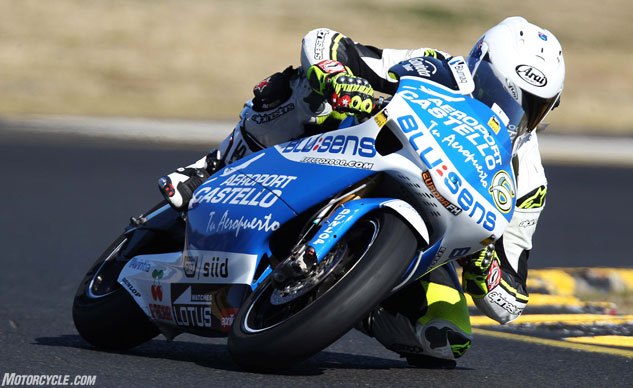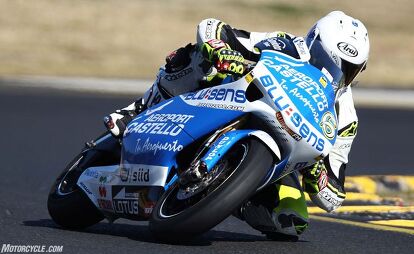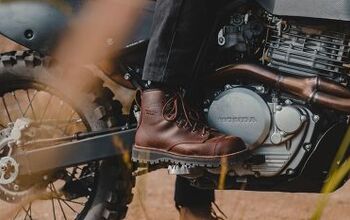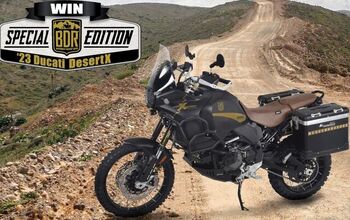2007 Aprilia RSW250 Grand Prix Bike Test
Rippin' on a factory-backed two-smoker!
The chance to ride a real-deal 250 Grand Prix World Championship bike is the stuff dreams are made of. I grew up obsessed by 250GP racing. In my teens, in the 1990s I knew every rider, every race number, had the posters on my bedroom wall and all of the races taped on videotape! As soon as I got my Learners, I was on the road on an old RZ250FN, followed by a few TZR250s before I started roadracing on RGV250s in 1995. Even my RGV racebike was painted the same colors as the Ralf Waldman HB 250. Riding the RGV proddie, I dreamed of one day being a 250 GP rider.
Fast forward 22 years and I find myself about to ride a proper RSW250 Aprilia thanks to the owner, Harry, who kindly offered us a spin. Things have changed with my 250 GP aspirations, though. Not only am I over 40, I also weigh more than the bike!
About the bike. It is trick. It is expensive. It is rare and absolutely stunning. The peak of two-stroke development is right here under the fairings
This is the Aprilia Racing RSW250 ridden by Eugene Laverty in the 2008 250 Grand Prix World Championship. It is the real deal and very, very rare, not to mention priceless. The swingarm alone is worth 50 grand! The RSW250 was made by Aprilia from 1991 to 2007. It has been ridden to world titles by the likes of Max Biaggi, Valentino Rossi, Marco Melandri, and Jorge Lorenzo and has won countless memorable races. With just over 100 horsepower at the wheel and weighing in at less than 200 pounds, the power-to-weight ratio is incredible.
The frame is hand-made aluminum, as is the fuel tank. The seat unit and rear hump is a complete A-kit part only for factory teams, all carbon-fiber monocoque, and the wheels and swingarm are carbon-fibre also. The engine is cast magnesium, and every single nut, bolt, axle, and washer is titanium. The massive ram-air system and airbox is also carbon-fiber, as is all of the bodywork. It truly is a work of art, and at this level of racing, you can see where a million bucks go. Its 249cc 90-degree V-Twin two-stroke revs to over 12,000 rpm and is the absolute trickest little engine I’ve seen. The opportunity to actually get in there and have a good look was heaven, as these bikes were always so guarded when they were competing of course.
What is immediately apparent is the size of the engine compared to a production 250 two-stroke. There is nothing there that is not needed, and everything has been developed and refined to be absolutely as compact and lightweight as possible. The clutch is tiny, as is the gearbox and cases. The other side has the small magneto flywheel and ignition pickup. The expansion chambers are gorgeous – titanium with carbon-fiber mufflers, and the airbox and carburetors are so mind-blowingly trick. Just look at those pictures and drool!
The wheels are factory items that simply cannot be bought. Ever. Brakes are factory spec monoblock radial-mount calipers with cast-iron rotors. Carbon-fiber brakes were available for some situations also. Öhlins factory suspension is at both ends. Rumor has it the fork is worth 20 grand. The triple clamps are titanium and the handlebars carbon-fiber. Everything is tiny, compact, almost under-engineered.
What may seem like a simple two-stroke is far from it. Aside from the technology in the tuning of the porting, combustion chamber, crankcases, and expansion chambers, there is a complex fueling and powervalve system along with full data logging and even traction control. Yes, you read that right.
The datalogger system, which is the factory Aprilia one that came with a staff member for the teams, provides all aspects of data from braking to suspension and ignition and jetting. The software tells the team what jetting to change after each session, based on the live atmospheric conditions and data from the previous run. The traction control system is an ignition curve based one that uses an algorithm to determine rear-wheel slip based on throttle position, wheel speed, gear and so forth, similar to what is now used in modern motocross and enduro two-stroke factory race bikes.
Everything on the RSW is hand-made and the bike is a work of art. It looks amazing from any angle. Actually, I have blown up one of the photos we took and I have it as a poster above my workbench in my garage. This bike makes me feel young I guess. All of those dreams I had as a teenager about racing in 250…
The Ride
Nerves. Adrenaline. Excitement. Those three things that make you feel just a little bit sick in the stomach, well, they are all off the chart as Harry warms the bike up.
I close my visor as he rolls the bike out into pit lane of Sydney Motorsports Park, formerly known as Eastern Creek. If I’m riding a 250 GP bike, I’m walking out to it like a boss, visor down and cameraman snapping away! Ha!
I hop on the bike and immediately think, ‘How the hell and I going to fit in this? I think back to when I was 19 and skinny and I just squash myself into Laverty’s ergonomics. The nerves settle a little as I blip the throttle and get the engine up to temperature. My old two-stroke days are flooding back to me and there is a crowd gathering around the bike. It is loud. Very loud…
When you ride road production bikes for so long, it is easy to forget how a proper handling thoroughbred feels and there is no comparison to any street-going bike at all, not even close. The RSW is beyond telepathic. It’s an extension of my body more than a bike; well, that is how it is making me feel.
Watching GP rider’s highside for a few decades is in the back of my mind exiting the turns on my out lap, but I’m soon surprised at the amazing tractability and drive of the RSW. It is jetted a little on the conservative side, so hasn’t got that razor’s-edge sharpness to the throttle, but still, it is on song and almost four-stroke like in some aspects. It pulls third gear where I would have expected second, or where a TZ250 or RS250 Honda would need a lower gear and or more revs. Amazing stuff by Aprilia.
The gearbox is ultra-close-ratio, and the quickshifter super sensitive. The engine starts making power from as low as 8000 rpm but really comes alive up top, where it pulls harder than most 1000cc bikes around while feeling like it is the weight of a bicycle.
Its steering response is insane. At first I am oversteering and hitting inside ripple strips as I’m just too used to conservative geometry and weight. But once my brain slows things down a bit I steer with a bit more finesse and begin to find some rhythm there. The same goes for the brakes, one finger and even then I almost go over on the first lap. They are as strong as the best street sportbike, say an S1000RR or Panigale, but then double the power and sensitivity and imagine the bike also weighed a third as much, that will give you an idea. Comparing the RSW brakes to an RSV4, say, is like comparing RSV4 brakes to a 1972 RD250…
I settle down and start my session proper. Tucking in on the front chute I’m chasing gears as the engine revs so quickly it is incredible. The straight disappears faster than usual and suddenly I’m into the ultra-fast Turn 1. I touch the brakes gently with one finger and pop it down to fourth gear. Getting back on the gas, I cannot believe how rapidly the 250 accelerates towards Turn 2. In fact, I have to grab fifth gear. I’m in shock and arrive at my usual braking point for T2 faster than I would on any superbike. I ride straight past my braking point, in fact still on the gas, and don’t start braking until I’m turning in. It is no problem; the RSW just goes deep, stays tight and hold a perfect line through the double-apex corner. I feel like I can put the bike anywhere, anytime.
Getting the rpm right is not as crucial as it is on a TZ or RS, so although high corner speed and high rpm are still required, there is some forgiveness there for a lard-ass like me who doesn’t get it inch perfect every lap. The bike hauls out of 2, over 3 and is on the back wheel cresting the hump into Turn 4. Having watched Biaggi and company on video thousands of times here from the 1994 and 1995 races, I actually have one of those dream moments where I feel like they must have felt. It is surreal. I guess it is like a person with a passion for music suddenly finding themselves playing a stadium!
Up the hill out of Turn 5 with the engine in the sweet spot, the bike pulls with amazing urgency up this steep hill and again does the same to Corporate Hill, another bumpy long left-hand crest.
Braking into the Turn 9 hairpin, the feedback is so direct I feel like my hands are holding the front axle! I’m waiting for Biaggi, Waldman, Capirossi or Harada to dive up the inside!
My lap ends and I’m in. Just rolling into pit lane, after watching so many legend 250 riders at Aussie GPs ride down this entrance, I feel like the luckiest man alive. That’s one dream ticked off the bucket list…
2007 Aprilia RSW250 Specifications | |
|---|---|
| Engine | 249cc 90-degree V-Twin two-stroke |
| Bore & stroke | 54 x 54.5mm |
| Displacement | 249cc |
| Compression ratio | 12.0:1 |
| Fuel delivery | 42mm flat slide VHSE magnesium carburetors |
| Exhaust | DLR carbon-fibre mufflers and Aprilia Racing titanium expansion chambers |
| Power | 110hp @ 13,000 rpm |
| Gearbox | Cassette-style adjustable ratios |
| Clutch | Dry |
| Final drive | Chain |
| Chassis | Aluminium handmade |
| Wheelbase | Variable |
| Rake & trail | Variable |
| Suspension | Factory Öhlins front and rear |
| Brakes | Brembo |
| Wheels | Carbon-fiber |
| Wet weight | 200 lbs |
| Price | Around five new RSV4s |
More by Jeff Ware














































































Comments
Join the conversation
A modern meaty litre+ sportbike has its virtues - but the path of mad 250/350cc two strokes from before the 70's rd400 and through the 80s rd350lc has been lost mainly because the average age of bikers has got too old (and legislation....). There should be a modern road going version of this Aprilia - less than 100KG, maybe a 350 twin, and pushing out 110hp+ that'd run rings around four stroke competitors like street triples and indeed anything else on roads that have any kind of bend in them.
Agreed, good article.
I did a session on a TZ250 a few years ago and that was an eye opener , had to reprogramme my brain , this by comparison is in another league altogether